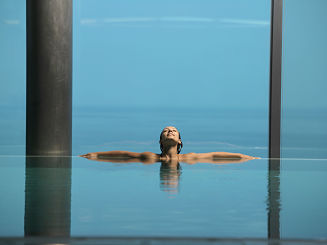Exercises, that slow and deepen the breathing bring a ‘feel – good’ factor to the body while also relaxing and resting the mind. Yoga practice releases tension in the physical body and also frees obstructions in the nadis or energy channels. It is important to choose a posture that is comfortable and sustainable. The traditional postures for meditation such as the yoga poses of Padmasana (lotus posture) or Virasana (hero posture), hold the body in stillness on a stable foundation, while allowing energy to flow freely along the spine as start to turn our focus inward. The classical yoga asanas are designed to promote strength, balance, breath and focus. This makes them ideal exercises for all the koshas, and an excellent preparation for the meditation. Vrksasana -tree posture (above) is one of the classic yoga postures used in preparation for meditation practice.
The traditional position for meditation practice is to sit with the knees out to each side. This creates a pyramid with a firm triangular base so that it is difficult to topple over and easy to keep the spine erect, even when you are totally engrossed in inner experiences. Sitting with spine erect allows flow energy between the ‘heaven’ (light) and ‘earth’ (life) poles of our being. Energy needs to flow smoothly up and down through the physical spine and energy channels of the subtle bod, so that the brain and breathing function optimally and the chakras are balanced and full of vitality. An erect spine is quite easy to maintain if the right props are used to begin with and the right exercises are performed regularly to strengthen the muscles that hold the spine erect and open the hip joints. However, in Western society people seldom sit in this position.
Focusing on the breath is a universal technique for enlightenment and healing, and many traditions use breathing practices wither as a way to prepare for meditation of as meditation techniques for themselves. The technique of holding the breath – either in or out, safely requires one to one teaching, but becoming aware of the breathing process and directing the flow of the breath is within the capacity of everyone. Slowing down the breathing and lengthening the breath out switches the nervous system into its peaceful happy mode, allowing stress to be dissolved and rest, digestion, absorption and healing to take place at every level of five koshas.
Relaxation is quite different from mediation and should not be confused with each other. Relaxation practices are done lying down in as comfortable a position as possible. Western psychotherapists usually favor a reclining position because their technique require the client to be relaxed as they follow a guided visualization or answer questions from the past. Meditation practices take us deeper than this, with the mind quietly focused on a single object.
The most external levels of our being are our physical body and our energy flow. Through a sequence of gentle movements and techniques that foster awareness of the breath, we can bring both these levels into a state of harmony so that we can sit comfortably and peacefully for meditation practice.












